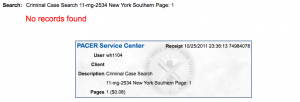The Implications of DOJ’s FOIA “Lies”
On Thursday, we learned it has been the practice of DOJ for nearly a quarter century to provide misleading information in response to FOIAs asking for certain kinds of information–broadly, ongoing investigations, informants, and foreign intelligence.
In this post I want to consider how the practice may be ripe for abuse.
Here’s the statutory language in question, Section 552(c) of FOIA:
(c)(1) Whenever a request is made which involves access to records described in subsection (b)(7)(A) [ed: this is the law enforcement exception] and – (A) the investigation or proceeding involves a possible violation of criminal law; and (B) there is reason to believe that (i) the subject of the investigation or proceeding is not aware of its pendency, and (ii) disclosure of the existence of the records could reasonably be expected to interfere with enforcement proceedings, the agency may, during only such time as that circumstance continues, treat the records as not subject to the requirements of this section.
(2) Whenever informant records maintained by a criminal law enforcement agency under an informant’s name or personal identifier are requested by a third party according to the informant’s name or personal identifier, the agency may treat the records as not subject to the requirements of this section unless the informant’s status as an informant has been officially confirmed.
(3) Whenever a request is made which involves access to records maintained by the Federal Bureau of Investigation pertaining to foreign intelligence or counterintelligence, or international terrorism, and the existence of the records is classified information as provided in subsection (b)(1) [ed: this is the exemption for information that has been properly classified according to Executive Order], the Bureau may, as long as the existence of the records remains classified information, treat the records as not subject to the requirements of this section.
Let’s take each of these in order.
Ongoing Legal Investigation
The first exclusion–for information that might tip the subject of an investigation into a potential crime to that investigation and therefore lead her to, for example, destroy evidence–makes a bit of sense.
But it seems ripe for abuse in several ways.
First, DOJ can only exclude these files if “the subject of the investigation or proceeding is not aware of its pendency.” But DOJ gets to decide whether the subject of an investigation really “knows” she is being investigated or not. As the Meese Guidelines governing this practice explain,
Obviously, where all investigative subjects already are aware of an investigation’s pendency, the “tip off” harm sought to be prevented through this record exclusion is not of concern. Accordingly, the language of this exclusion requires agencies to consider the level of awareness already possessed by all investigative subjects involved as they consider employing it. It is appropriate that agencies do so, as the statutory language provides, according to a good-faith, “reason to believe” standard, which closely comports with the “could reasonably be expected to” standard utilized both within this exclusion and in the amended form of Exemption 7(A).
This “reason to believe” standard for considering a subject’s pre-existing awareness should afford agencies all necessary latitude in making such determinations. As the exclusion is phrased, this requirement is satisfied so long as an agency determines that it affirmatively possesses “reason to believe” that such awareness does not in fact exist. Read more →



 Duqu isn’t Christopher Lee in Attack of the Clones, but it is the newest computer malware to hit mainstream consciousness. It’s attracting attention mainly because it is based on the same software source code base as the Windows portion of Stuxnet. If you haven’t heard about Duqu, check out the
Duqu isn’t Christopher Lee in Attack of the Clones, but it is the newest computer malware to hit mainstream consciousness. It’s attracting attention mainly because it is based on the same software source code base as the Windows portion of Stuxnet. If you haven’t heard about Duqu, check out the